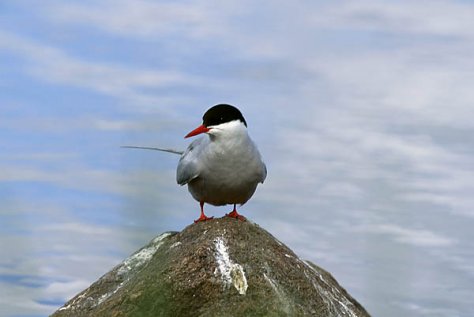Arctic tern
Photo: Arne Ader
Translation: Liis
 Arctic tern on seashore boulder.
Arctic tern on seashore boulder.
| Arctic tern |
|
Randtiir | Sterna paradisaea |
.
There are two species of terns with a red beak and red legs in Estonia: the arctic terns that just now mostly lay on their eggs on the seashore, and have proportionally very short legs, and the common terns who inhabit inland waters, and have quite normal proportions. If the beak or leg colour is other than red, a bird identifier must be used: then we have to do with terns that rarely occur in Estonia.
The colonies of arctic terns are small, and the first eggs have been laid in the nests. A full clutch contains two or three eggs, the incubation period lasts nearly three weeks and the nestlings fledge in August. At first the new generation is fed insects that fly at the water surface, such as dragonflies, supplemented later with small fish. Fish is the basic food of arctic terns. The nest is usually on open land, and the terns attack people who happen to come near it very fiercely. It is prudent to leave quickly! In contrast other birds are accepted quite peacefully.
The winter quarters of arctic terns are in southern Africa and on the coast of the Antarctic mainland, and their breeding areas stretch to the polar regions. Scientists have recorded a migration distance of seventeen thousand kilometres for one individual.








